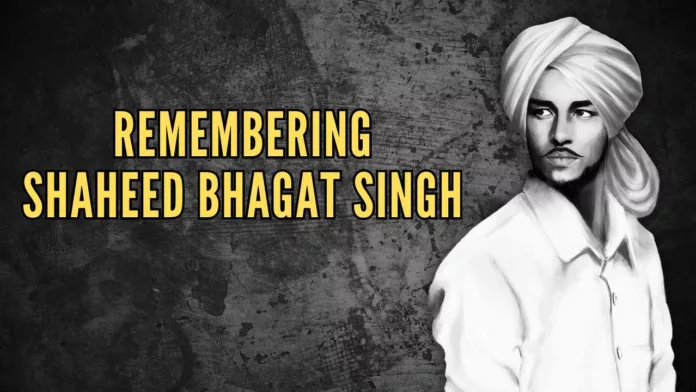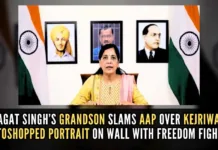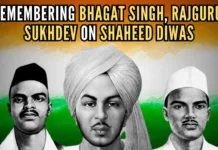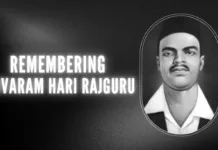
Remembering Shaheed Bhagat Singh, India’s Greatest revolutionary, on his birth anniversary
The life of Bhagat Singh is one filled with great and inspiring messages for all the people of the Indian sub-continent and in fact, for the entire world. He is held in high regard by both the people of Modern India and Modern Pakistan. He is revered across Akhand Bharat. He is revered by people of the Hindu, Muslim, and Sikh communities. He is a person, who has risen above divisions of race, caste, religion, and even nationality. It is important that the people of the Indian subcontinent or the ‘Jambudweepa’ realize the unity in our diversity and join hands in friendship in our common quest to realize legitimate human aspirations based on the eternal rules of justice, truth, and fraternity.
It is important to note the impeccable contributions of Bhagat Singh. There are very few people in this world (past, present, and future) who can replicate the greatness of Shri. Bhagat Singh, who lived for a mere 23 years on this mortal plane but whose contributions to the cause of his motherland will be remembered for eons to come. There are many who live long but contribute very less to their societies but Bhagat was a generous soul. He gave his all for our motherland and was finally martyred on the 23rd of March 1931 in Lahore, when he along with his comrades, Sukhdev Thapar and Shivaram Rajguru were hanged within the Lahore Jail premises, secretly by the dirty British stooges after 7 p.m. in the evening and their bodies burnt with petrol and thrown into the Sutlej River! They were supposed to be hanged on the 24th of March. However, the hanging was preponed by a day and carried out secretly because the British were afraid of the repercussions of their dastardly act among the Bharatiya people. The extreme cowardice and cruelty of the British was revealed by this tragedy.
Such was his commitment to the causes of the emancipation of his motherland, his desire for an egalitarian and just economic and social society, a society with no communalism, his international outlook, and his atheistic religious tendencies that he was respected and feared by even his opponents. He left his family and did not even marry. He wholeheartedly served our nation till his last breath along with his beloved comrades and Bharat Mata’s most beloved children – Shri. Chandrashekar Azad, Shivaram Rajguru, and Sukhdeo Thapar. Bhagat Singh rose above all human barriers and boundaries. He rose above race, religion, region, and even nationality. It is most likely that had Bhagat Singh lived longer, Bharat might have never been partitioned. Bhagat Singh is revered by both the people of India and Pakistan. He is an icon for Sikhs, Hindus, Muslims, Christians, and for everyone. Such was the magnificence of his passion for his motherland! He was a leader as popular or even more popular than Mohandas Gandhi. Bhagat Singh wore his heart on his sleeve and was truthful and upright. He never played politics for his personal benefit. He gave his all for our Bharat motherland.
Bhagat Singh, the great patriot, socialist revolutionary, atheist, and internationalist was born in the village of Banga, which was part of Lyallpur district in undivided Bharat (now in Faisalabad district, Pakistan) on the 27th of September 1907. His family members were passionately involved in the freedom struggle for Bharat. His parents were Vidyavati Kaur and Sardar Kishan Singh. Some of his relatives had been arrested or imprisoned by the contemptuous British rulers. Bhagat Singh belonged to the Sikh community and his family was economically rich. Bhagat Singh displayed a tremendous passion for patriotism from a young age.
The main events, which changed the course of the life of Bhagat Singh leading to his early martyrdom at the age of 23 were the following –the Rowlatt Act, the Jallianwala Bagh Massacre, the Non-Cooperation Movement, the event at Chauri-Chaura, the Kakori Train Conspiracy, the killing of Officer Saunders and the Central Assembly bombing at Delhi.
The Jallianwala Bagh Massacre of April 13th, 1919 had a deep impact on him. He was a 12-year-old child at that time. The massacre was a fallout of the draconian Rowlatt Act and the cruelty of Evil British General O’Dyer. Thousands of people died in the Jallianwala Bagh Massacre in Amritsar in Punjab. On the day of the Festival of Baisakhi, a large number of people had assembled inside the Jallianwala garden to protest against the Rowlatt Act and the arrest of some leaders. They were brutally massacred. Bhagat was shaken by the brutality of the illegitimate British masters. His entire life was against imperialism and pro-revolution. His endearing and unchanging slogans were ‘Inquilab Zindabad’ and ‘Samrajyavad Murdabad’ (‘Long Live Revolution’ and ‘Down with Imperialism’).
Bhagat was always a courageous and intellectual person from a young age. He studied at Dayanand Anglo-Vedic School and later at National College at Lahore and not in any British-run school or college. Bhagat Singh was always loyal to his country and was not one of those people, who licked the feet of the British master and who were greedy and afraid of the British. Bhagat Singh was a patriot above everything else. He would also become an internationalist and a social revolutionary inspired by Karl Marx and the Russian Bolshevik revolutionary, Vladimir Ilyich Lenin.
Bhagat Singh was an atheist by belief in spite of having been born in an orthodox Sikh family and a socialist in his ideological leanings. He was never ever a Communist.
Bhagat was also a voracious reader and he was an extensive reader, who read on different topics. He read a lot of books on polity, economy, social life, and culture.
Bhagat Singh was an enthusiastic participant in the Non-Cooperation movement, which began in 1919. He was very unhappy when the Freedom Fighter, Shri. Lala Lajpat Rai was lathi-charged on 30th October 1928. He along with many other patriots felt devastated when the revered Lalaji succumbed to the head injuries on 17th November, 1928. For, the first time, doubts entered Bhagat’s mind regarding the ability of Gandhiji and whether Gandhi’s ahimsa policy would lead to the emancipation of Bharat. Truth be told, all Bharatiya people know now it was not merely Gandhiji’s method of ahimsa, which got freedom for Bharat but also the himsa or violence policy followed by Bhagat Singh and other revolutionary freedom fighters like Chandrashekhar Azad, who were inspired Veer Damodar Savarkar’s book, ‘First war of Indian Independence in 1857’ and the travails of Savarkar. Later, SC Bose would take the Cudgels against the British inspired by the revolutionary freedom fighters like Bhagat Singh and Savarkar.
Bhagat Singh was very unhappy when Gandhiji called off the Non-Cooperation Movement after the incident at Chauri-Chaura.
On 4th February 1922 at Chauri-Chaura, an angry Bharatiya mob set fire to a police station. 3 Civilians and 22 policemen died in the Chauri-Chaura incident. The uncomfortable truth that Gandhiji comfortably forgot was that the mob had only retaliated to the continuous persecution of innocent indigenous Bharatiya people by an illegitimate, dastardly British imperialism, who were controlling the people and resources of Bharat over which they had no rights whatsoever. The traders from thousands of kilometres from the Indian sub-continent were pretending to be legitimate rulers. The truth was that the police had opened fire upon a large group of protestors participating in the Non-Cooperation Movement. The burning down of the police station was only an act of retaliation. Bhagat understood that Bharat would never be able to get independence through non-violence. He understood that Bharat would need to adopt a multi-pronged strategy to get independence. To put it simply, Bhagat Singh was disillusioned by Gandhi’s appeasement tactics and non-violent principles.
Bhagat Singh met his fellow revolutionaries like Sukhdev Thapar and Bhagawati Charan during his college days at the National College in Lahore. He also made other life-long friends like Chandrashekhar Azad and Shivaram Hari Rajguru. It would take the efforts of Stalwarts like Veer Savarkar, Chandrashekhar Azad, Bhagat Singh, and Shivaram Rajguru along with countless other revolutionaries like Veer Savarkar, Rash Behari Bose, and Subas Chandra Bose along with efforts by persons like Gandhi to win independence for Bharat.
Bhagat joined the Kirthi Kisan Party in 1926 in Lahore. He started writing for ‘Kirthi’ and wrote against the atrocities of the British. He was a very good writer and a voracious reader. He also started the Naujawan Bharat Sabha in 1926. The main aim behind the formation of the Naujawan Bharat Sabha was to bring the soldiers and farmers of Bharat, together and to unite people from all religions with the final aim of freeing Bharat from British rule and to bring about Socialism in Bharat. Bhagat wanted the British to leave Bharat and he also wanted Bharat to be ruled by a government, which would provide both social and economic justice to its people. Towards this goal, Bhagat paid a huge personal price.
Bhagat’s refusal to marry caused much sorrow and consternation among his parents and relatives but Bhagat stood his ground and did not yield to emotional blackmailing of any kind. He was determined to serve his motherland. He left his parental home in Punjab and went to Kanpur in present-day Uttar Pradesh. Bhagat Singh’s revolutionary career got a fillip after he went to Kanpur. It was in present-day Uttar Pradesh where he met the revolutionary stalwarts, Chandrashekhar Azad, Shivaram Rajguru, and others.
In 1927, the Kakori train conspiracy was carried out by the HRA – Hindustan Republican Association. Ram Prasad Bismil and 4 other revolutionaries were hanged and 16 were given life imprisonment.
In the same year, 1927, The Simon Commission came to India. Protests were carried out. Lala Lajpat Rai was one of the protesters. He was lathi-charged by the police of the British imperialist Raj. Lala Lajpat Rai died soon after succumbing to the grievous injuries. Before he died in the hospital, he said that his death would be the last nail in the Britishers’ coffin.
Bhagat Singh and other revolutionaries became very angry seeing all this injustice and planned for revenge for Lala ji’s death. The revenge was planned by the revolutionaries, especially by Chandrashekhar Azad, Bhagat Singh, Shivaram Rajguru, and Jai Gopal. They all decided to part in the assassination of Police Officer, James Scott, who had ordered the lathi-charge on Lalaji. Revolutionary Jai Gopal was designated with the duty to identify the officer. Unfortunately, on the day of the assassination on 17th December 1928, Jai Gopal wrongly identified his assistant, Officer Saunders as Officer Scott. Bhagat Singh and Shivaram Rajguru mistakenly killed Officer Saunders in Lahore. This revolutionary act led by Chandrashekara Azad was indirectly inspired by revolutionaries like Ram Prasad Bismil and Veer Vinayak Damodar Savarkar. They would be forerunners of the revolutionaries, Rash Behari Bose and Subhas Chandra Bose. Thus, there was a constant rising of revolutionaries. The first round of revolutionaries included Veer Vinayak Damodar Savarkar. The second and third round of revolutionaries included members of HRA and then HSRA led by Azad, Bhagat, and others. R B Bose and S C Bose were the other great revolutionaries. Thus, it would be a horrible fallacy to think that only Gandhi and a handful of leaders got freedom for India. Nothing can be further from the Truth. Credit should be given where it is due.
In fact, it was Bhagat who initially brought back the idea of Vasudeva Kutumbakam or ‘The World is One Family’. Swami Vivekananda too, believed in this and the present central dispensation, too follows this motto.
After the death of Saunders, the police searched for the perpetrators everywhere but were not successful. Bhagat Singh, Chandrashekhar Azad, etc were masters of deception and evaded the police by disguising themselves well.
There was a need to rebuild HRA. Soon, Bhagat met Shri. Chandrashekhar Azad. The two stalwart freedom fighters decided to merge the Naujawan Bharat Sabha and the Hindustan Republican Association. In September 1928, there was a secret meeting at Feroz Shah Kotla, Delhi, and the merged entity was born- the Hindustan Socialist Republican Association. The word ‘Socialist’ had been added.
The tyrannical, evil, and cunning British imperialists were unable to catch Bhagat or his comrades on their own. Finally, it was Bhagat Singh and Bhatukeshwar Dutt, who after their bombing of the Central Assembly in Delhi in 1929, voluntarily surrendered themselves before the Police. This was to show their opposition to the draconian and anti-proletariat bills – the Trade Disputes Bill and the Public Safety Bill. The Trade Disputes Bill was against the rights of the workers and the Public Safety Bill was anti-people.
A lot of people have tried to portray Bhagat Singh as a Communist. However, it is contrary to the truth. While it is true that Bhagat Singh had socialistic tendencies, it is untrue and unfair to say that he was a Communist.
Another researcher, Kama Maclean in his book, ‘A Revolutionary History of Interwar India’ wrote about the relationship between the Hindustan Socialist Republican Association and the Mainstream National Movement.
There were many revolutionaries, who contributed to Bharat’s freedom struggle – Vasudev Balwant Phadke, Chapekar brothers – Damodar and Balkrishna, Khudiram Bose, Madan Lal Dhingra, Prafulla Chaki, Kartar Singh Sarabha (THE IDOL OF BHAGAT SINGH), Basant Kumar Viswas, Ramprasad Bismil, Ashfaqulla khan alongside the fearsome foursome, Chandrashekhar Azad, Bhagat Singh, Shivram Rajguru and Sukhdeo Thapar.
The Leftists have always tried to project Bhagat Singh as a Leftist, which is nothing but setting a false narrative. Although Bhagat was pro-socialist, he was not a Marxist. Both the C.P.I. and the C.P.I.(M) have tried to appropriate the legacy of Bhagat Singh but have not been successful so far. Bhagat Singh never advocated Communism.
According to Swami Sumedhanand Saraswati, the Arya Samaj played an important role in shaping Bhagat Singh. According to him, Bhagat Singh was influenced by the ideals of the Arya Samaj. Schooling at DAV, Lahore must have influenced young Bhagat in multiple ways.
According to the renowned Professor, Shri. Chaman Lal – ‘There is a great deal of effort today by various forces to appropriate the legacy of Bhagat Singh. The Mainstream Nationalist Historiography and its concomitant political current, the Congress holds him up as a selfless patriot but totally ignores his strong anti-Congress stance.’ It is to be noted that the largest number of Bhagat Singh have been brought out by Prof. Chaman Lal.
A trend began in the 1970s… Bipin Chandra and other left academics tried to portray in vain to portray the ‘Communist’ tendency of Bhagat Singh. In his work, ‘ The ideological development of the revolutionary terrorists in North India in the 1920s’, Bipin Chandra says – ‘ The Socialist within him had finally overcome the terrorist.’ It is indeed, shameful that from such a position of intellectual disrespect, Bipin Chandra declared all of a sudden that – ‘Bhagat Singh was a critical revolutionary mind in the best traditions of Marx, Engels and Lenin’. Well, Communists have always been shape-shifting and Chamaeleon-like.
The Communists who had called Bhagat Singh a terrorist suddenly began to see him as a Communist icon. This is a classic case of the cunning misappropriation of an iconic freedom fighter as their own by the Communists as they don’t have Bharatiya Heroes of their own. Although it is true that Bhagat Singh read books by Karl Marx, Frederick Engels, Lenin, and Stalin, and was enamoured by the ideologies and personalities, it cannot be said with certainty that he approved of Communism. Rather, he was a votary of Socialism, which allows for private ownership and private rewards. All great thinkers and writers are good readers and it is more likely that Bhagat read more books to increase his general understanding of the world.
The shallowness of the Communists can be understood by understanding the official Communist response to the Meerut Conspiracy Case of 1929-33 – ‘We oppose terrorism not because of any sentiments on the subject of violence but we are convinced of its uselessness as a practical revolutionary party. Individual terrorism is essentially a petty bourgeois policy. It arises from an exaggeration of the role of the individual, who conducts the attack.’
It is shocking, surprising, and downright irritating that the Communists, who had once called Bhagat Singh ‘a terrorist; suddenly began to see him as their Hero’.
In 1986, Shiv Varma brought out the publication known as ‘Selected Writings of Bhagat Singh’ in which he clearly stated, “Revolutionaries started and remained as Hindu nationalists till the end. The objective of the revolutionaries was to drive out the British and establish a Hindu Raj in India.’
Bhagat Singh was a voracious reader. He read many books including novels like Maxim Gorky’s ‘Mother’, Victor Hugo’s ‘Les Misérables’, Charles Dickens ‘Tale of Two Cities’, Sinclair’s ‘Jungle’, ‘Boston’ and ‘King Kol’. We must understand that Bhagat Singh was young and would have been influenced a great deal by the books as well as his society. However, Bhagat Singh transmuted his energies to serve the larger cause of freedom for Bharat, for spreading his ideas of Socialism, internationalism, and atheism. We must never forget that he stood for the rights of the working class. He was respectful towards women and a loving friend. He maintained a spotless personal life. He would have shed tears of blood if he had witnessed the horrors of Partition. He would never have allowed partition to happen. We must never forget that Bhagat Singh belongs to Akhand Bharat. He belongs to Sikhs, Hindus, Muslims, and atheists. He was a remarkable man.
Bhagat Singh said that – ‘Bombs and pistols cannot bring revolution. The sword of revolution is sharpened on thoughts. He also said that lovers, lunatics, and poets are all made of the same material. Bhagat Singh was a passionate poet. He wrote a lot in Hindi although Punjabi was his mother tongue. Bhagat understood the value of a common national link language.
Anthropologist Christopher Pinney was shocked to note that the images of Bhagat Singh were more prevalent than those of Gandhiji among the public. Gandhi ji was given more importance in the official narratives of the nationalist movement. In other words, ‘certain forces’ might not have wanted Bhagat Singh and his comrades to succeed!
Lezia Lakhvir has written an article, which talks about the greatness of the lineage of Bhagat Singh. Five generations of his family were part of the Bharatiya freedom struggle.
All are born and know that they will meet with Death, someday. Bhagat was not afraid of death. He has become immortal and the fragrance of his soul fills the entire world and he will live forever through his writings and his deeds. His soul shall not meet with destruction in this world or in any other. He remained an atheist till his last breath. Bhagat Singh did not believe in the existence of God. He wrote an article on atheism explaining why he was an atheist.
Bhagat Singh was a person with special traits and abilities. He was a bibliophile and a good writer. He was popular with all groups of people. It is quite possible that the history of India might have been different had Bhagat Singh lived longer. He rose above many barriers and served his motherland with the greatest sense of devotion and sacrifice! Long Live Bhagat Singh! Long live Chandrashekhar Azad! Long live Shivaram Rajguru! Long Live Sukhdev Thapar! Long Live Revolution!
23rd March is Celebrated every year as Martyrs Day in India.
Note:
1. Text in Blue points to additional data on the topic.
2. The views expressed here are those of the author and do not necessarily represent or reflect the views of PGurus.
For all the latest updates, download PGurus App.
- Shaheed Diwas: Remembering Bhagat Singh, Rajguru, Sukhdev on Martyr’s Day - March 23, 2024
- Chhatrapati Shivaji Maharaj – The unparalleled visionary leader - February 19, 2024
- The Constitution Day of Bharat - November 26, 2023










